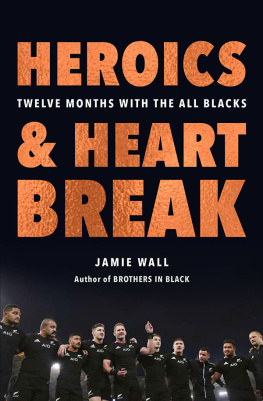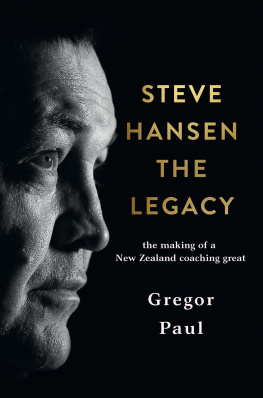The story of the All Blacks from the other side of halfway. Big names from all their fiercest rivals talk about meeting the worlds most successful rugby team in some of the greatest tests of all time.
This brilliant selection of photographs and stories describes what it means to stare down the most famous ritual in sport, from the perspective of those who have been there. Facing the Haka examines the significance that the All Blacks haka has in the wider rugby world, as well as the deep respect opponents have for the team.
This is about standing in front of the haka, meeting the All Blacks on those key occasions, and reliving the stories of the games that followed. Facing the Haka covers many crucial moments in rugby history with great storytelling, fresh insights and all the information a fan could ask for.
The All Blacks perform the haka at the 2011 Rugby World Cup ahead of their clash with France in pool play. PHIL WALTER/AFP VIA GETTY IMAGES
Flames erupt as the England team faces the All Blacks haka at Eden Park in June 2014. DAVID ROGERS/GETTY IMAGES
To everyone who made this book possible.
At the business end of this project we faced a challenge no one saw coming, but we pulled through and got the job done.
Jamie
To my mum and dad, Kerry and Lynn Burt.
From the frosty early mornings at Fraser Park wearing the green and white hoops of Hutt Valley Marist to the 3am wake-up calls to watch the All Blacks take on South Africa, thank you for introducing me to the wonderful game of rugby and sparking a lifelong passion. Although you are not here to display this book proudly on your coffee table or flick through the pages on a warm Urenui day, I know you will be smiling down and checking for any typos.
Love, Andy
CONTENTS
/
LEARNING THE
HARD WAY
TATOU O E TAU
LE TAUA!
WHEN THE STAKES HAVE
NEVER BEEN HIGHER
THE GREAT
HAKA REVIVAL
KIERAN READ
TAKES THE LEAD
AN EPIC
ENCOUNTER
THE HAKAS HOLLYWOOD
CONNECTION
CHIP ON THE
SHOULDER
FACING THE
BLACK FERNS
TE TMATANGA FOR
AN IRISH ICON
FROM LEADING THE
HAKA TO FACING IT
THE WELSH
STALEMATE
THE BRAVE BLOSSOMS STARE DOWN THE
CHALLENGE
THE MEN WHO SUMMONED
THE THUNDER
FOREWORD
WHETHER PERFORMING HAKA OR on the receiving end of a spirited performance, it is hard to deny that haka moves people; it inspires and unites, and can challenge at times. The reason for this perhaps lies in the essence of what haka isand that is an outlet whereby an individual or a group can express a deeply held conviction or a strong emotion.
When Te Rauparaha, the famous Mori chief of the Ngti Toa Rangatira tribe, uttered the now famous words Ka mate, ka mate, ka ora, ka oraI am close to death, death is upon me, yet I live still, indeed I am alive!he did so in the form of a haka. As h translates to breath and k translates to ignite, his haka delivery would have been spirited and expressive to all present. He would have been drawing on the deep emotion that a near-death experience brings, having been pursued by a war party intent on his demise. It is haka that gave life to his feelings and emotions.
The Mori world has long used haka to convey important messages, feelings and thoughts across all manner of topics. Tribal matters, political decisions, individuals actionsnoble or otherwise, to name a few. Regardless of the topic, it cannot be denied that haka offers a unique and very Mori way of expressing a groups or individuals position or feeling.
You dont have to look far in Aotearoa to see how deeply fused haka is into the fabric of our country and way of life. Outside of its use in sport, you will regularly see haka performed in the workplace, at schools, weddings, funerals, birthdays and more. But it is probably the ability of haka to unite, inspire, convey identity and establish connections that has seen haka move beyond the Mori culture to embed itself into the wider Kiwi culture and indeed into the world of rugby.
The association between rugby and haka has a rich history spanning more than 130 years. Since the New Zealand Natives team first performed haka during their tour of Britain in 188889, haka has endured and grown across all of rugby. From the All Blacks and Black Ferns to junior clubs and community rugby, haka can be found at all levels of the game.
Some of the most spectacular haka are performed when school First XV rugby teams play their traditional rivals and close to a thousand students are on-field at opposite ends supporting their teams. The New Plymouth Boys High First XV whole-of-school pre-game haka is truly a sight to behold, with every student in the school lined up on the terraces at Pukekura Park. It is fair to say that haka is so ingrained in rugby that it is hard, if not impossible, to imagine Aotearoa New Zealand rugby without haka.
Now that we know what the haka is and why we do it, we can truly appreciate what it means to face the haka. I look forward to reading this book and finding out what the thoughts, feelings and emotions were of players who have faced up to a haka from one of our mighty teams in black.
LUKE CRAWFORD, NGTI POROU, NGTI TWHARETOA, MORI ALL BLACKS KAUMTUA
HE
WHAKAPUAKITANGA
AHAKOA HE HAKA TE mahi, he mtakitaki rnei i ttahi haka whakawanawana, e kore e taea te tohe i te mana o te haka ki te whakapukepuke i ng kare -roto, ki te whakaaweawe me te whakakotahi, me te wero an hoki i na w. Ko te take pea kei roto tonu i te iho o te haka, he huarahi e taea ai e te tangata, e te kapa rnei, te whakapuaki i ng whakapono me ng karekarenga ngkau.
I te w i a Te Rauparaha, te rangatira Mori rongonui o te iwi o Ngti Toa Rangatira, ka k ake i ng kupu Ka mate, ka mate, ka ora, ka ora i whakapuakina m roto mai i te haka.
Ko te h he kupu m te hauh te tangata, , ko te k he kupu m te hikanga o te ahi, , kore e kore ko tana haka he mea wana, he mea whakangahau i ng kaimtakitaki. Ka tkirikirihia e ia ng tauwharewharenga o te ngkau m roto mai i ng krero m na wheako i te tatanga o tana rironga ki a Aitu i a ia e arungia ana e ttahi ope tau kia patua ia kia mate. N te haka na kare -roto i whakaora mai.
Kua roa te ao Mori e whakamahi ana i te haka ki te whakapuaki krero, kare -roto, whakaaro hoki m ng kaupapa huhua. Ko ng take -iwi, ng whakatau trangap, ng mahi te tangataahakoa pai, kore rneitahi o ng kaupapa. Ahakoa te kaupapa, kore pea e taea te tohe i te heinga o te haka ki te tuku i ttahi huarahi whakapuaki krero m te rp, m te tangata rnei.
Ehara i te mea me ruku hhonu te tangata ki te ahurea o Aotearoa ki te kite i te whenumitanga o te haka ki roto i te kahu o te whenua nei me ng huatanga ia r. Hunga r ia na whakamahinga i te rngai hkinakina, ka kitea hoki te haka i ng whi mahi, i ng kura, ng mrena, ng tangihanga, ng huritau, me te nui noa atu o ng kaupapa.




















